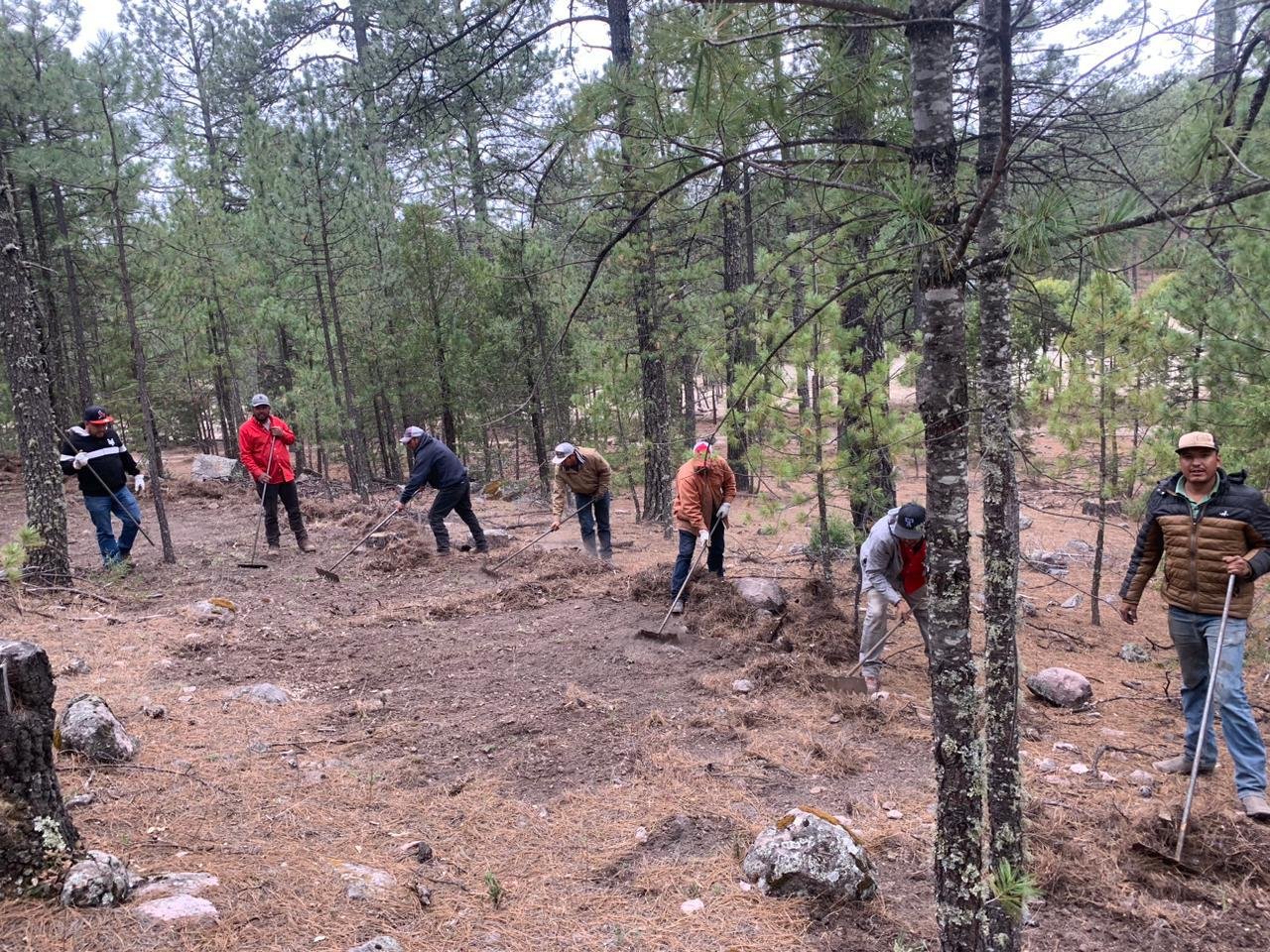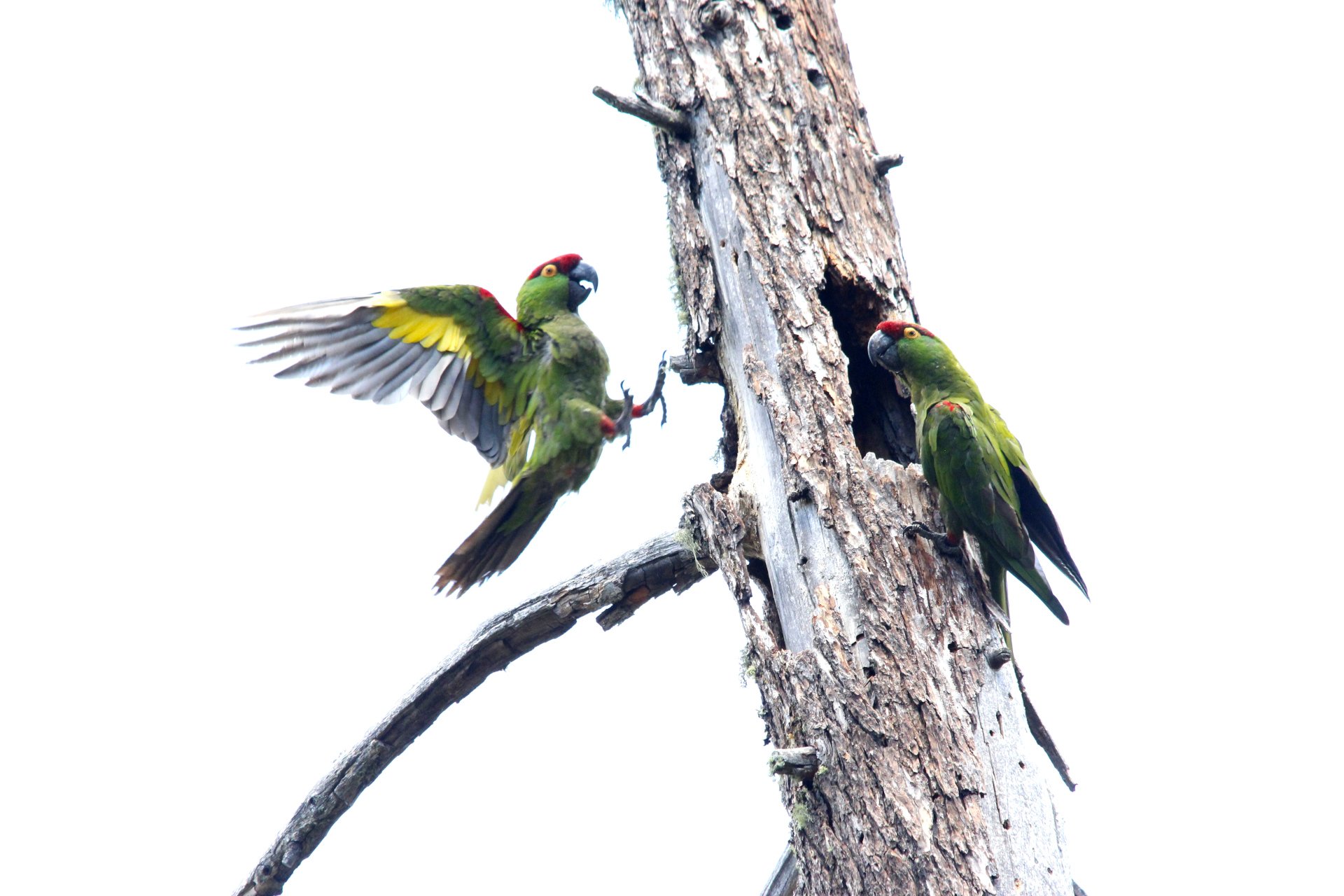Frontline Heroes: Defending the Endangered Thick-Billed Parrot From Wildfires
How a community brigade in Chihuahua, Mexico, became the first line of defense against wildfires that threaten the habitat of an endangered bird.
This beautiful bird once soared through the skies of the southern United States. Photo by Manuel Escárcega / CONANP
The Thick-Billed Parrot: Keeper of Forests
Starting at the barrel and spiraling up the pinecone, a dangerously sharp beak over an inch thick individually pries off each pinecone scale to reach its seed. In a graceful balancing act, the thick-billed parrot unravels its meal by grasping the pinecone with one foot while perching high atop pine trees with the other.
Parents teach this complicated process to their young, passing down the knowledge it takes to utilize their sturdy beaks that have evolved to open pinecones, acorns, and a variety of other nuts and fruits to survive in concert with the forest offerings. In response, mature forests depend on these green parrots to crack open their pinecones’ protective shells and drop seeds eager to find soil.
In their wake, thick-billed parrots create forests by dispersing seeds in flocks of up to 12-100 birds as they migrate between high-altitude, mature forests and return to the same nesting sites year after year.
While this bird once flourished from the U.S. to Mexico, its range is now limited to a small part of northwest Mexico in the Sierra Madre Occidental’s old-growth forests. They prefer to nest in pine trees up to 200 years old, whose thick trunks provide enough space for the parrots to build their nests by enlarging existing hollows that either occur naturally or are made by woodpeckers.
Map of the parrot sanctuaries, our project area, and their surrounding natural protected areas in Chihuahua and Sonora, northwest Mexico. Map by Juan Carlos Bravo / Wildlands Network
Deforestation from logging and agriculture as well as the pet trade have long contributed to habitat loss and their restricted range. In addition, wildfires have become a major threat to the birds and their habitat with fires burning bigger, hotter, and longer than ever before. Intense fires that reach the tree canopy are especially dangerous for these high-perching birds, which are more likely to occur in the absence of typical low-height, frequent fires.
Without their last remaining habitat, these forest creators will go extinct, putting the future of the forests in jeopardy as well. The intimate relationship between birds and trees, each giving life to one another, is a critical part of this ecosystem. Without one, the other breaks down.
From the tallest tree, a thick-billed parrot spots the sanctuary’s ancient forests. Photo by Manuel Escárcega / CONANP
The forest in our project area. Photo by Mirna Manteca / Wildlands Network
Despite this important relationship, the thick-billed parrot’s population has been steadily declining. Now, instead of flocks of 2,000 birds, experts estimate that only a total of around 2,000 individuals remain. It’s now an endangered species on the IUCN Red List of Threatened Species.
Protecting the Parrots
To save this species, their home needs protection from deforestation and wildfires. Reducing logging and comprehensive forest management are critical to avoid the destruction of the entire ecosystem. However, these forests are wild and remote in terrain that’s difficult to access. The only people close enough to respond to immediate threats and consistently manage the forests are those who live among them, like the local communities of Tutuaca and Conoachi in Chihuahua. These communities have lived in these forests the longest and know them better than anyone else.
Members of the community brigade. Photo by Mirna Manteca / Wildlands Network
So, teaming up with them wasn’t just logical – it was essential. And that’s what we’ve done for the last 24 years. We started by funding a compensation package that transitioned local communities away from logging in the more sensitive areas in which the parrots nest annually. In 2019, in partnership with the National Commission of Natural Protected Areas (CONANP) and Pronatura Noreste, our strategy evolved into a habitat-management program where we now fund the training and equipping of the same communities to prevent and manage wildfires.
In 2015, these communities formed a brigade, comprised of ejido (community-owned land) volunteer members – all without much experience managing fires, but with a deep understanding of the land and a passion for its protection. When our training began in 2022, the group solidified into the Preservation Area Community Brigade, a cohesive unit of 10 volunteers.
Members of the community brigade collect organic combustible material as part of their fire prevention measures. Photo by Carlos Castillo / Wildlands Network
They initially strapped up with the resources they had, some of them putting out fires while wearing huaraches – sandals. Over time, our funding supplied fire-resistant shoes, helmets, jackets, wind-measurement tools and other resources needed to prevent and manage fires. In the last year, we supported fire suppression and mitigation efforts to clear canopy-threatening vegetation near the parrots’ nesting sites in the Tutuaca Flora and Fauna Protected Area.
In 2023, nine active nests and 58 parrots were located in the project area.
Collecting fallen logs is essential for prevention efforts, as these logs and other organic material are highly flammable. Photo by Mirna Mantca / Wildlands Network
Put to the Test: Results in Wildfire Season
“Over the last three years, we’ve noticed that the drought has had an impact on populations of birds and other species,” notes Samuel Bencomo Jiménez, president of ejido Conoachi. “Wildfires are also more aggressive.”
In 2024, Mexico has experienced the most devastating wildfires it has ever seen, in part from rising temperatures and drought conditions. By March, 120 actively burned across Mexico.
Meanwhile, the brigade conducted preventative wildfire management, which included cleaning combustible material and debris around the nesting sites and administering prescribed burns. “We also completed a firebreak surrounding the protected area,” said Adán Mendoza, chief of the Preservation Area Community Brigade.
“We’re working hard to protect our land and the thick-billed parrot.”
Adán Mendoza, chief of the Preservation Area Community Brigade
In April, three unusually intense wildfires broke out miles from the parrots’ nesting site. The fire quickly moved, decimating centuries-old forests. Every day they burned, the flames put the parrots and their delicate habitat at extreme risk; many days it inched closer to the parrots themselves.
Thanks to the brigade’s preventative work and its swift response, the fires did not reach the nesting area. One was as close as 100 meters (a little over 100 yards) from the nesting site.
Carlos Castillo, Northwest Mexico Program Co-Director (left) with Samuel Bencomo Jiménez, President of ejido Conoachi. Photo by Mirna Manteca / Wildlands Network
“In total, between the community brigade and additional reinforcement groups, it took 660 firefighters to quell the three fires, each lasting multiple weeks and burning as much as 37,000 acres of forest. These are major undertakings that rely on this community to consistently manage the habitat and to respond quickly when wildfires break out,” noted Carlos Castillo, Wildlands Network’s northwest Mexico program co-director, while highlighting the brigade’s heroic work.
In 2023 and 2024, the 10 members of the Preservation Area Community Brigade alone maintained over 18 miles of firebreaks and cleaned combustible material in over 245 acres, helping to minimize and extinguish six total fires. With valor and hard work, the brigade’s enormous effort has saved every parrot nest in the project area.
“We’ve seen the changes – before this project, we had no unified brigade to protect this preservation area. We now are well prepared to fight against wildfires,” said Bencomo.
At the end of the summer, we counted the bird nests again.
Thick-billed parrots make their nests in old, dry trees. Photo by Manuel Escárcega / CONANP
While nine nests lived in the project site in 2023, in 2024, the number had grown to 23 nests – a 2.5x increase from the previous year alone.
“These results speak to the importance of wildfire management and the critical role community leaders play in supporting their surrounding landscapes. Like the parrot keeps the forest, the communities of Tutuaca and Conoachi protect the ecosystem,” Castillo added.
While our efforts will continue to focus on protecting the ecosystem, we’re collaborating with other organizations that are constantly researching the species, gathering data on population counts, migration patterns, nesting, and more. We still have much to learn about the thick-billed parrot and need to protect the remnants of mature forests that constitute its habitat, both inside and outside protected areas. By complementing each other's efforts, we aim to conserve the thick-billed parrot in the most effective way possible.
With the resounding successes from this year, we’re hopeful for the future of the thick-billed parrot and the generations of forests it will create for years to come.











